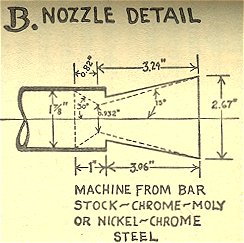Rocketry: The Last Blast
Today, a parable about childhood's end. The University of Houston's College of Engineering presents this series about the machines that make our civilization run, and the people whose ingenuity created them.
The movie October Sky told the story of four teenage West Virginia boys who, in the late 1950s, built a rocket that made it six miles into the sky. At the same time, at least two of my colleagues were building their own rockets, using the same grass-roots methods. Sputnik had inspired a generation to learn rocketry.
One of those colleagues has lent me a book titled Rocket Manual for Amateurs. It came out in 1960. By then, he and all the other first generation of rocket boys had gone on to college. This book is meant to make things easier for a new crop of teenagers.
When I start turning pages, I'm astonished. This truly is rocket science. Here is an excellent grounding in chemistry, fluid mechanics, trigonometry. It's all wonderfully demystified.
 Indeed, if you read the book Rocket Boys — the basis for the October Sky movie — you'll find four boys learning all this from scratch, and by trial and error. The book tells how to make fuel, shape a nozzle, select materials, measure the height of ascent, arrange a control center, build test stands. It talks about expansion ratios and applied mechanics.
Indeed, if you read the book Rocket Boys — the basis for the October Sky movie — you'll find four boys learning all this from scratch, and by trial and error. The book tells how to make fuel, shape a nozzle, select materials, measure the height of ascent, arrange a control center, build test stands. It talks about expansion ratios and applied mechanics.
And yet it loses something along the way. How to define the loss? The rocket boys of the late fifties created their own questions. They found out that, to create a supersonic jet, a nozzle had to first converge, then diverge. They learned that a rocket fuel cannot just explode like gunpowder, and that the location the rocket's center of gravity is important. They'd seen Sputnik, and set out with great determination, to replicate it.
Learning to stay alive while you handled the serious dangers of rocketry was another trial-and-error process that young mechanics and inventors would be denied after the 1950s. This manual goes into great detail describing protective measures and first aid. Now you'd learn safety first, and rocketry second.
Something shifted just after Sputnik. We became postmodern; we became circumspect. The chasm between the Rocket Boys and this manual is vast. Every fiber of common sense tells us to learn how first, and then do. Learn to be safe before you play with fire.
Yesterday I went for X-rays. I'd suffered a blow to the chest and the pain persisted. Had I broken a rib? No, but the X-ray revealed other ribs, long broken, healed over, and forgotten. My growing up in the thirties and forties yielded so many bumps and scars — who's to keep track? I was lucky to live, while others died or were maimed.
So this lovely manual was written after-the-fact. It sums up what the last wild children of twentieth-century modern American had learned. And it embodies a pernicious have-your-cake-and-eat-it-too problem. Our children need to find new inventive risks and dangers without killing themselves. I don't know how that's possible, but it certainly is essential.
I'm John Lienhard, at the University of Houston, where we're interested in the way inventive minds work.
(Theme music)
Brinley, Capt. B. R., Rocket Manual for Amateurs. New York: Ballentine Books, Inc., 1960.
The two "rocket boy" colleagues at UH are Lewis Wheeler and Alan (Russ) Geanangel. I am grateful to Russ Geanangel for lending me the Brinley book.
For more on "The Rocket Boys" see Episode 1421.

The Rocket Manual's specification of a safe launching pit.